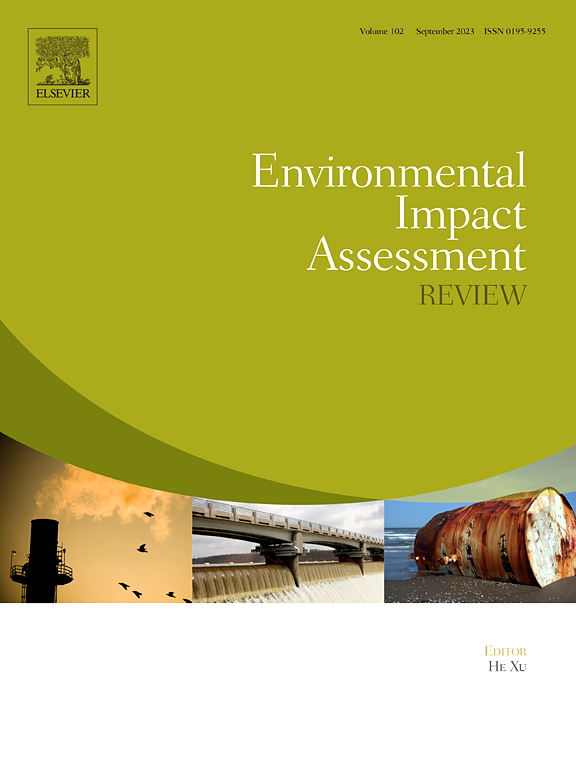边界生态系统服务与风险的综合优化:考虑过去与未来的多尺度探索
IF 11.2
1区 社会学
Q1 ENVIRONMENTAL STUDIES
引用次数: 0
摘要
在城市化加速和气候变化的共同作用下,全球生态环境正在经历一场系统性危机,生态系统失衡已超过地球边界阈值。边境地区作为国家安全的一线,其生态系统安全模拟研究不足。本研究以中国陆地边界云桂地区为例,耦合一系列区域差异和时空映射模型,识别和模拟多尺度的生态系统服务和风险,从而建立生态安全区综合优化框架。结果表明:(1)长江流域生态系统服务与风险具有时空异质性和区域相互作用。生态系统服务指数(ESI)呈先上升后下降趋势,从1990年的0.3775下降到0.3769。到2020年,生态系统风险指数(ERI)上升到0.4063。ESI与ERI的时空权衡关系揭示了跨境经济区喀斯特地形敏感性与人类活动的耦合效应。(2)不同发展情景下边境生态安全存在显著差异。在安全稳定情景综合优化下,生态系统服务能力显著提高,比2020年增长6.22%;生态系统风险得到有效缓解,比2020年降低37.88%。(3)边贸口岸和中心城镇作为边境线地缘经济社会发展的核心区,是边境线生态保护系统工程需要重点关注和治理的重点区域。因此,需要建立全球边境生态安全网络,分析跨边界、跨尺度、跨要素的生态系统服务风险相互作用,系统应对“保护-发展”挑战。本文章由计算机程序翻译,如有差异,请以英文原文为准。
Integrated optimization of border ecosystem services and risks: A multiscale exploration considering the past and future
The global ecological environment is undergoing a systemic crisis driven by the combined effects of accelerated urbanization and climate change, with the ecosystem imbalance exceeding planetary boundary threshold. Border regions, serving as the frontline for national security, remain understudied, with insufficient research on ecosystem security simulations. This study takes the Yunnan-Guangxi region of China's land border (YGCB) as a case study, coupling a series of regional disparity and spatiotemporal mapping models to identify and simulate ecosystem services and risks across multiple scales, thereby establishing a comprehensive optimization framework for ecological security zones. The results indicate that: (1) The ecosystem services and risks in the YGCB exhibited spatiotemporal heterogeneity and regional interactions. The ecosystem service index (ESI) initially increased but later declined, dropping from 0.3775 in 1990 to 0.3769. The ecosystem risk index (ERI) rose to 0.4063 by 2020. The spatiotemporal trade-off relationship between ESI and ERI revealed the coupled effects of karst terrain sensitivity and human activities in the cross-border economic zone. (2) Significant variations exist in border ecological security across different development scenarios. Under the integrated optimization of security stabilization scenarios, ecosystem service capacity is markedly improved, showing a 6.22 % increase compared to 2020 levels, while ecosystem risks are effectively mitigated with a 37.88 % reduction from 2020 baselines. (3) As the core zones of geo-economic and social development in the YGCB, the border trade ports and central towns remain critical regions requiring focused attention and governance in the systematic engineering of border ecological protection. Therefore, the establishment of a Global Border Eco-Security Network is called for to analyze ecosystem service-risk interactions across borders, scales, and elements, systematically addressing the “protection-development” challenge.
求助全文
通过发布文献求助,成功后即可免费获取论文全文。
去求助
来源期刊

Environmental Impact Assessment Review
ENVIRONMENTAL STUDIES-
CiteScore
12.60
自引率
10.10%
发文量
200
审稿时长
33 days
期刊介绍:
Environmental Impact Assessment Review is an interdisciplinary journal that serves a global audience of practitioners, policymakers, and academics involved in assessing the environmental impact of policies, projects, processes, and products. The journal focuses on innovative theory and practice in environmental impact assessment (EIA). Papers are expected to present innovative ideas, be topical, and coherent. The journal emphasizes concepts, methods, techniques, approaches, and systems related to EIA theory and practice.
 求助内容:
求助内容: 应助结果提醒方式:
应助结果提醒方式:


